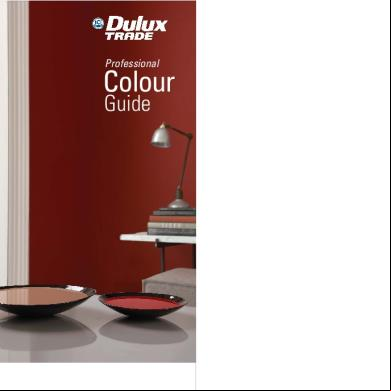Dulux Breeam Voc Information 1r1061
This document was ed by and they confirmed that they have the permission to share it. If you are author or own the copyright of this book, please report to us by using this report form. Report l4457
Overview 6h3y3j
& View Dulux Breeam Voc Information as PDF for free.
More details h6z72
- Words: 860
- Pages: 2
ICI Paints AkzoNobel Wexham Road Slough Berkshire SL2 5DS
T +44 1753 550000 F +44 1753 877442 www.akzonobel.com
Date: July 2014 Summary: Based on the information below ICI Paints AkzoNobel declares compliance with BREEAM “Hea 9” 2008 & “Hea 02” 2011 Background: In order to recognise and encourage a healthy internal environment through the specification and installation of internal finishes and fittings with low emissions of Volatile Organic Compounds (VOCs), the BREEAM assessment method allocates credits to buildings demonstrating compliance with certain assessment criteria. 1.0 Volatile Organic Compounds (VOCs) – Decorative Paint Directive 2004/42/CE: All paint and varnish products manufactured by ICI Paints AkzoNobel including products sold under the brands Dulux Trade, Armstead Trade (formerly Glidden Trade), Cuprinol, Sikkens and Hammerite conform to the VOC content limits in Phase 2 of 2004/42/CE Directive as per the requirement of BREEAM “Hea 9” 2008 and “Hea 02” 2011, and the VOC labelling is present (as required by the Directive) on the back of pack livery. 1.1 Volatile Organic Compounds – calculation method: The BRE Technical Group confirmed in Jan 2011 (Ref: ETQ2774) that, for the purpose of compliance with the BREEAM “Hea 9” 2008 and “Hea 02” 2011 criteria, determining the VOC content of paints using the calculation method described in Note 1 below (in lieu of testing in accordance with ISO standards) is acceptable. The decision has been made on the grounds that the calculation method described in Note 1 below is accepted for CHIP (Chemicals Hazard Information and Packaging for Supply) regulations. Acceptance is subject to the results of such calculations demonstrating that the product(s), in of their VOC content, conform to the VOC emission level required in BREEAM “Hea 9” 2008 and “Hea 02” 2011, i.e. Phase 2 of 2004/42/CE for decorative paints and varnishes. 2.0 Fungal and algal resistance: A particular requirement for “Decorative paints and varnishes” in BREEAM “Hea 9” 2008 and “Hea 02” 2011, is the ability to demonstrate fungal and algal resistance. All waterbased products manufactured by ICI Paints AkzoNobel including products sold under the brands Dulux Trade, Armstead Trade, Cuprinol Trade, Sikkens and Hammerite contain in-can and film biocides where the formulation type and conditions of use of the product require the use of these additives. The in-can biocides used across all water-based ICI Paints AkzoNobel products provide protection against a wide range of microorganisms in order to prevent spoilage of the paint in the can. In-film biocides are used in all of our exterior products providing protection against fungi and algae as appropriate. ICI Paints AkzoNobel do not add biocides to interior products to protect against algae, as algal growth in normal interior situations is not a problem. Generally, bacteria and fungi are also not a problem in interior modern housing. Specialist interior products are available, however, for the prevention of bacterial Imperial Chemical Industries Ltd is part of AkzoNobel th ed Office 26 Floor Portland House Bressenden Place Page 1 o 2
London SW1E 5BG ed number 218019
or fungal growth on the paint film for situations where conditions are conducive to such microbial colonisation. This approach avoids the use of biocides unnecessarily which is in line with the ICI Paints AkzoNobel product stewardship policy.* Based on the addition of protective biocides where needed, and without any specific measurement of resistance levels, ICI Paints AkzoNobel products demonstrate compliance for “fungal and algal resistance” as stated in BREEAM “Hea 9” 2008 and “Hea 02” 2011. Conclusion: Based on the above mentioned information, ICI Paints AkzoNobel declares compliance with BREEAM “Hea 9” 2008 & “Hea 02” 2011. Signed on behalf of ICI Paints AkzoNobel:
John B Staunton Customer Marketing Manager, Commercial Market
Richard Snelgrove Trade Team Leader, Research & Development
Note 1: The preferred method to determine the VOC content in a paint formulation is to use a calculation technique rather than using the ISO test method quoted in Directive 2004/42/CE (which is ISO 11890-2:2002, not BS EN 13300:2001 as quoted in the BRE documentation). Each paint product is manufactured to a controlled formulation where the quantities of all the raw materials in the mixture are accurately known. For the calculation, all the paint raw materials are broken back to their component chemical substances and assessed for VOC content as defined in the Directive, from the safety data sheets and additional information obtained from the supplier of each raw material. During the ISO 9001 certified manufacturing process each raw material is accurately added to produce the paint formulation and, therefore, the quantity of VOC that goes into each paint batch is known accurately from the calculated sum of all VOCs present in all the raw materials. The VOC content of all paint formulations produced is identified using this process, and ICI Paints AkzoNobel believe this is a more accurate, more reliable and more efficient method of ensuring compliance with the VOC Regulations compared to carrying out VOC testing of paint batches using the test standard method.
*This information has been compiled by AkzoNobel Microbiology Expert Group Imperial Chemical Industries Ltd is part of AkzoNobel th ed Office 26 Floor Portland House Bressenden Place Page 2 o 2
London SW1E 5BG ed number 218019
T +44 1753 550000 F +44 1753 877442 www.akzonobel.com
Date: July 2014 Summary: Based on the information below ICI Paints AkzoNobel declares compliance with BREEAM “Hea 9” 2008 & “Hea 02” 2011 Background: In order to recognise and encourage a healthy internal environment through the specification and installation of internal finishes and fittings with low emissions of Volatile Organic Compounds (VOCs), the BREEAM assessment method allocates credits to buildings demonstrating compliance with certain assessment criteria. 1.0 Volatile Organic Compounds (VOCs) – Decorative Paint Directive 2004/42/CE: All paint and varnish products manufactured by ICI Paints AkzoNobel including products sold under the brands Dulux Trade, Armstead Trade (formerly Glidden Trade), Cuprinol, Sikkens and Hammerite conform to the VOC content limits in Phase 2 of 2004/42/CE Directive as per the requirement of BREEAM “Hea 9” 2008 and “Hea 02” 2011, and the VOC labelling is present (as required by the Directive) on the back of pack livery. 1.1 Volatile Organic Compounds – calculation method: The BRE Technical Group confirmed in Jan 2011 (Ref: ETQ2774) that, for the purpose of compliance with the BREEAM “Hea 9” 2008 and “Hea 02” 2011 criteria, determining the VOC content of paints using the calculation method described in Note 1 below (in lieu of testing in accordance with ISO standards) is acceptable. The decision has been made on the grounds that the calculation method described in Note 1 below is accepted for CHIP (Chemicals Hazard Information and Packaging for Supply) regulations. Acceptance is subject to the results of such calculations demonstrating that the product(s), in of their VOC content, conform to the VOC emission level required in BREEAM “Hea 9” 2008 and “Hea 02” 2011, i.e. Phase 2 of 2004/42/CE for decorative paints and varnishes. 2.0 Fungal and algal resistance: A particular requirement for “Decorative paints and varnishes” in BREEAM “Hea 9” 2008 and “Hea 02” 2011, is the ability to demonstrate fungal and algal resistance. All waterbased products manufactured by ICI Paints AkzoNobel including products sold under the brands Dulux Trade, Armstead Trade, Cuprinol Trade, Sikkens and Hammerite contain in-can and film biocides where the formulation type and conditions of use of the product require the use of these additives. The in-can biocides used across all water-based ICI Paints AkzoNobel products provide protection against a wide range of microorganisms in order to prevent spoilage of the paint in the can. In-film biocides are used in all of our exterior products providing protection against fungi and algae as appropriate. ICI Paints AkzoNobel do not add biocides to interior products to protect against algae, as algal growth in normal interior situations is not a problem. Generally, bacteria and fungi are also not a problem in interior modern housing. Specialist interior products are available, however, for the prevention of bacterial Imperial Chemical Industries Ltd is part of AkzoNobel th ed Office 26 Floor Portland House Bressenden Place Page 1 o 2
London SW1E 5BG ed number 218019
or fungal growth on the paint film for situations where conditions are conducive to such microbial colonisation. This approach avoids the use of biocides unnecessarily which is in line with the ICI Paints AkzoNobel product stewardship policy.* Based on the addition of protective biocides where needed, and without any specific measurement of resistance levels, ICI Paints AkzoNobel products demonstrate compliance for “fungal and algal resistance” as stated in BREEAM “Hea 9” 2008 and “Hea 02” 2011. Conclusion: Based on the above mentioned information, ICI Paints AkzoNobel declares compliance with BREEAM “Hea 9” 2008 & “Hea 02” 2011. Signed on behalf of ICI Paints AkzoNobel:
John B Staunton Customer Marketing Manager, Commercial Market
Richard Snelgrove Trade Team Leader, Research & Development
Note 1: The preferred method to determine the VOC content in a paint formulation is to use a calculation technique rather than using the ISO test method quoted in Directive 2004/42/CE (which is ISO 11890-2:2002, not BS EN 13300:2001 as quoted in the BRE documentation). Each paint product is manufactured to a controlled formulation where the quantities of all the raw materials in the mixture are accurately known. For the calculation, all the paint raw materials are broken back to their component chemical substances and assessed for VOC content as defined in the Directive, from the safety data sheets and additional information obtained from the supplier of each raw material. During the ISO 9001 certified manufacturing process each raw material is accurately added to produce the paint formulation and, therefore, the quantity of VOC that goes into each paint batch is known accurately from the calculated sum of all VOCs present in all the raw materials. The VOC content of all paint formulations produced is identified using this process, and ICI Paints AkzoNobel believe this is a more accurate, more reliable and more efficient method of ensuring compliance with the VOC Regulations compared to carrying out VOC testing of paint batches using the test standard method.
*This information has been compiled by AkzoNobel Microbiology Expert Group Imperial Chemical Industries Ltd is part of AkzoNobel th ed Office 26 Floor Portland House Bressenden Place Page 2 o 2
London SW1E 5BG ed number 218019










